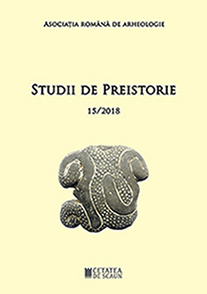Preliminary report on the faunal remains from the Early Neolithic site (Starčevo-Criș IIIB-IVA) at Tășad-Sere, Satu Mare County
Preliminary report on the faunal remains from the Early Neolithic site (Starčevo-Criș IIIB-IVA) at Tășad-Sere, Satu Mare County
Author(s): Georgeta El SusiSubject(s): Archaeology
Published by: Editura Cetatea de Scaun
Keywords: Tăşnad; Starčevo-Criş culture; faunal remains; wild horse; Equus hydruntinus
Summary/Abstract: Ca. 2,090 faunal remains were uncovered during the 2001 and 2017’s excavations at Tăşnad-Sere. The assemblage comprised five domestic species (cattle, sheep, goat, pig and dog) and seven wild species (aurochs, red deer, boar, roe deer, Equus hydruntinus, wild horse and brown bear). A single fragment comes from a bird, possibly a wild duck. The bones were collected from houses and different types of pits: storage, waste or clay exploitation. Domesticates make up 58.28% of the remains, against 41.72% for the game. Cattle account for 43.87%, followed by small ruminants (11.15%), pig (2.94%) and dog (0.72%). Among the hunted species the aurochs dominates by 13.53%. Other species with similar biotope requirements are roe deer (4.62%), Equus hydruntinus (1.11%), and wild horse (0.48%). The grouping of species claiming larger forested biotopes includes red deer (11.78%), boar (9%), and brown bear (0.8%). Skeletal elements from all body parts of wild specimens were identified, suggesting that the complete carcasses were brought into site for processing after the hunting. Special attention was given to antlers (mostly shed antlers from red deer) for tool-making. The high rate of immature individuals (ca. 56%) suggests large-scale consumption of beef. An important number of adult (20%) and elderly specimens (4%) points towards the keeping of animals for working, dairying and breeding. Goat was of little importance among the small ruminants. Meat production was the primary aim of small ruminants rearing. Pork played a small part in the diet. Cervids were an important source of food, pelt and raw materials. Most of the red deer individuals were full-aged, while in the case of the roe deer they were mostly immature. Both the Tăşnad location (at a higher altitude in contrast to lowland settlements - 79.4 m average altitude - from the Hungarian Plain) and its dating to a late sequence of the early Neolithic are reasons to explain its economy focused on bovines and game.
Journal: Studii de Preistorie
- Issue Year: 2018
- Issue No: 15
- Page Range: 51-71
- Page Count: 21
- Language: English

